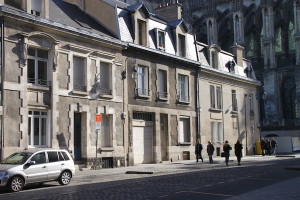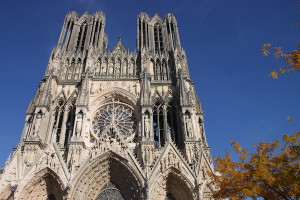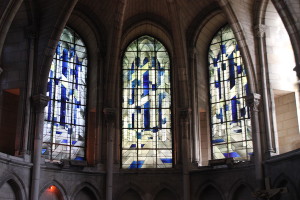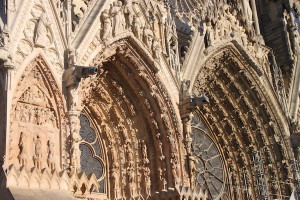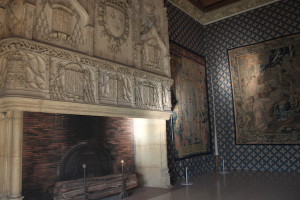Twenty-five French kings were crowned in Reims. These crowned heads included Charles VII with Joan of Arc at his side in 1429.
The city’s cathedral, a gothic confection built between the 13th and 15th centuries, was the setting for 19 of those coronations; a stone on its floor identifies its site as the place were Clovis, the founder of the original Frankish kingdom, was baptized around 500 A.D.
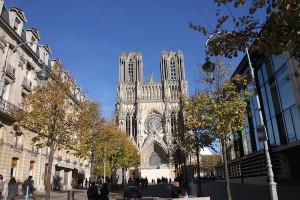
The approach to Reims Cathedral on a sunny October day. Construction on the cathedral began early in the 13th century, and it was the site of royal coronations beginning in 1223 (King Louis VIII).
For a wildly different distinction, Reims also is where the Germans signed papers surrendering unconditionally to end World War II in Europe.
On my most recent visit to Paris in October 2016, I settled on Reims for a day trip from the French capital. It had the history, which promised several touristic attracts of interest, and it was close enough to manage easily in a day.
Reims is in the Champagne wine region, which means, naturally, wine tours and tastings featuring champagne. Pursuing this seriously would require more than a day trip (in my opinion anyway). There are tastings options in Reims itself, too, but given I don’t care for champagne, I did not take time for that.
My journey began and ended on trains out of and back to Gare de l’Est in Paris, aboard the high-speed TGV, producing trips of about 45 minutes each. There are other considerably cheaper options, but they take longer and can involve train changes.
The Reims city center is a short walk from the train station, and station personnel, upon request, will provide a city map that usefully indicates a walking route for visitors. I relied on it.
A couple of attractions are Roman, the Mars Gate, a triumphal arch from around 200 A.D., plus a cryptoporticus, or underground passageway, dating from the third century. The underground space is open to visitors in summer, which means I did not see it.
What I did see was a gorgeous city hall, pretty town squares (especially Place Royale), plus a few houses dating from the 13th and later centuries that are now museums. Two houses were described on plaques as middle class homes, but looked to me to be several cuts above that, certainly by the standards of the relevant time period.
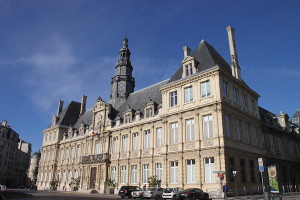
The gorgeous Reims city hall, built in the 17th and 19th centuries, then reconstructed after its destruction during World War I.
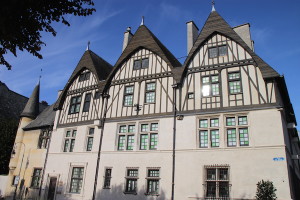
The Vergeur museum (Musee Hotel le Vergeur), described on a plaque as a former middle class home. Now a museum, it dates from the 13th and 16th centuries.
I would have enjoyed visits to their interiors, but with only a few hours and sun-drenched autumn scenes outdoors, I reserved my indoor sightseeing for the cathedral, an attached museum (former bishop’s palace) and the older St. Remi Basilica, which dates from the 11th century.
The cathedral, an outstanding example of gothic architecture, doesn’t look like a building that was in ruins at the end of World War I; its restoration was hugely aided by Rockefeller Foundation contributions. It is notable for the countless sculptures on the exterior and for its rose windows, best seen from the sanctuary on a sunny day in the late afternoon. I studied those windows, watching their vivid reds and blues, which seemed alive in the way of kaleidoscopes.
The cathedral was undergoing some maintenance including cleaning. There was a barricade blocking views of the facade, but fortunately, only around the central of three big doors, something that could be cropped out of most photos. Also, there was lots of scaffolding and shrouding at the back of the cathedral.
Parts of the front are newly cleaned and parts still quite dark, which produced an odd effect.
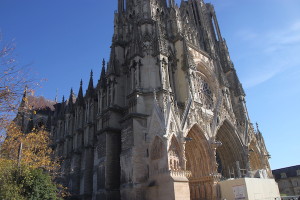
A Reims Cathedral photo showing which parts of the facade have been cleaned and which have not. The barricade blocking off a working area at the cathedral’s main door is visible at lower right.
Not wanting to dawdle over a long lunch, I settled into the square that fronts the cathedral with an ice cream cone in hand, a supremely relaxing way to enjoy the cathedral’s grandeur, the lusciously colored autumn leaves and the perfect weather.
Loitering in a great environment is restorative, but I wanted to see the St. Remi Basilica, which once served an attached and still-standing abbey, now a museum. Among other things, the basilica is known for the tomb of St. Remi (or St. Remigius), the man credited with bringing the Frankish king, Clovis, to Christianity. Much of the basilica also was reconstructed after World War I.
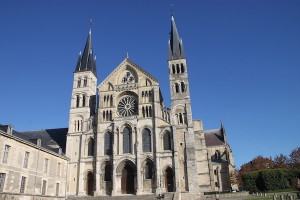
Exterior of Reims’ St. Remi Basilica, a structure that dates from the 11th century though much changed over the years.
In some ways, the basilica’s collection of stained-glass windows, including those from the 12th century, is more striking than the group at the cathedral. The collection boasts modern examples, too.
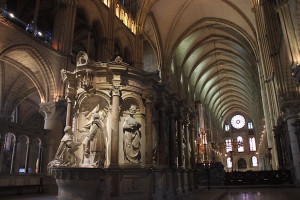
Tomb of St. Remi (St. Remigius), located in the St. Remi Basilica’s apse. The basilica’s long nave recedes in the background, at right.
From here, my strolls were pointed toward the train station, but I wasn’t leaving just yet. I was surprised to pass by a Carnegie library, a quite pretty circular building located behind the cathedral.
I had to see the cathedral’s windows again (the late-day light yielded more vivid colors) and eat a second ice cream cone (what’s better than one cone? make that two).
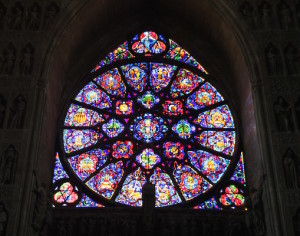
Rose window seen in the Reims Cathedral — but photos don’t do justice to the vivid colors of the cathedral’s windows when they are facing full late-day sun.
And, now it was time for a drop by at the former bishop’s residence, Tau Palace, to look at the cathedral’s treasury, several historic tapestries and some of the cathedral’s original statuary, now protected indoors.
Finally, time ran out, but somehow I had overlooked a rather obvious statue of the mounted Joan of Arc. Maybe I could use that as my excuse to return — as if I needed one.
For more about France, we offer at BestTripChoices.com the following, under the headline: S’il vous plait
https://besttripchoices.com/international-countries/france/
This blog and photos are by Nadine Godwin, BestTripChoices.com editorial director and contributor to the trade newspaper, Travel Weekly. She also is the author of “Travia: The Ultimate Book of Travel Trivia.”

